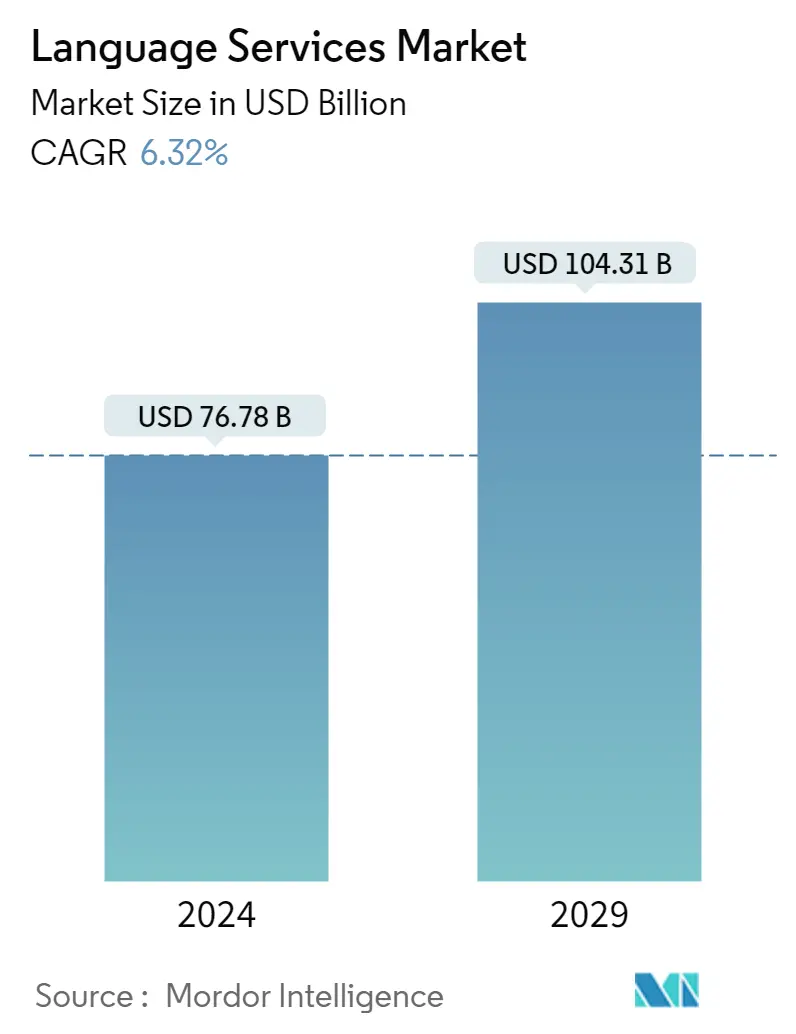Market Size of Language Services Industry

| Study Period | 2019 - 2029 |
| Market Size (2024) | USD 76.78 Billion |
| Market Size (2029) | USD 104.31 Billion |
| CAGR (2024 - 2029) | 6.32 % |
| Fastest Growing Market | Asia Pacific |
| Largest Market | North America |
Major Players
*Disclaimer: Major Players sorted in no particular order |
Language Services Market Analysis
The Language Services Market size is estimated at USD 76.78 billion in 2024, and is expected to reach USD 104.31 billion by 2029, growing at a CAGR of 6.32% during the forecast period (2024-2029).
- The primary factors driving the demand for language services include the rapidly increasing globalization among businesses, the incremental rise of digitizing content, and the increased customer service that's becoming more personalized and international.
- Iflytek, a speech recognition company based out of China that provides translation services, successfully raised USD 407 million (CNY 2.8 billion) from its investors, including the state-run investment fund China Reform Holdings and the Anhui Railway Development Fund. The company claims that the funding will be used to enhance the translation output, along with the output of the AI translation engine. Such developments provide significant scope for the market’s growth during the forecast period, especially for startups.
- The demand for language services is no longer concentrated on large multinational corporations. Still, small and large businesses and local and state governments, including other organizations, have increased their use of translation, interpretation, and other language services.
- International trade has steadily expanded over the past few decades, including the proliferation of free trade agreements that have led to a virtual explosion of global trade worldwide. Moreover, the increasing foreign competition and various government initiatives have led all kinds of businesses, irrespective of size, to take initiatives regarding opportunities available to them in foreign markets.
- The ongoing trends in international marketing are also expected to accelerate the growth in the language services market. With these services, companies are now able to reach increasing audiences across the globe at a lower cost through the web. The market is expected to grow even further as these audiences are increasingly composed of foreign people.
- The increase in internet usage, combined with the trend toward content marketing, has opened up new avenues for the language industry. PPC advertising and social media marketing aimed at foreign audiences are also expanding at remarkable rates. Social networking sites and multiple blogs that are active across the world are also providing platforms for effective content marketing that include articles, infographics, videos, and multimedia productions. All this content is localized for optimum effectiveness, which is one of the major factors driving the market.
- Moreover, the market is witnessing multiple M&A activities by the players to strengthen their market positions. For instance, in October this year, in order to assist life sciences organizations with their needs for international communication, including over-the-phone interpreting (OPI) for global call centers, Acolad Life Sciences teamed up with Alphanumeric.
- The lockdown restrictions amidst the pandemic forced the entire world to stay at home, which gave a strong impetus to developing trade and entertainment on the Internet. YouTube, Netflix, social media, and Amazon witnessed a surge in the number of users, producing the need for more content globally. That implies a higher demand for the services of translators, whose work is much easier to organize remotely.
- Another reason is the active exchange of experiences in fighting against the virus and treating patients, which drove the global discussion and information exchange between researchers in healthcare, virology, immunology, epidemiology, etc. The highest demand for translators may be expected from the medical sector.
- In March 2024, ABC Language Services merged with Language Link of Connecticut. The merger enabled ABC Language Services to better meet the translation needs of its clients, which comprise government agencies, law firms, medical practices, social services, corporations, and other businesses. Both companies continued to operate under their existing names, but now, they share all of their resources and operations.
- The lockdown restrictions amidst the COVID-19 pandemic forced the entire world to stay at home, which has given a solid impetus for developing trade via the Internet. Applications like Netflix, YouTube, Amazon Prime, and social media have witnessed a user surge. This has resulted in an increased need for more content globally and has served as good news for translators, owing to increased demand for their services while providing the ease of being organized remotely.
Language Services Industry Segmentation
The term "language services" refers to a group of language assistance programs that provide varying levels of interpreting, translating, understanding, localization, and other training services. They include various electronic, written, and multimedia materials for transcription, dubbing, narration, voice-over, and other uses. Language services offer many advantages to users, including efficient communication, broad geographic reach, high accuracy rates, skill development, and a highly participatory learning environment.
The language services market is segmented by services (translation, localization, and interpretation), end-user vertical (life sciences, media and entertainment, legal, finance, and patents and e-commerce), and geography (North America (United States and Canada), Europe (United Kingdom, Germany, France, Spain, Italy, and Rest of Europe), Asia-Pacific (China, India, Japan, and Rest of Asia-Pacific), and Rest of the World). The market sizes and forecasts regarding value (USD) for all the above segments are provided.
| By Type | |
| Translation Services | |
| Localization Services | |
| Interpreting Services | |
| Other Services |
| By End-user Vertical | |
| Life Sciences (Pharmaceuticals, Medical Devices, Biotechnology, CROs) | |
| Media and Entertainment (OTT, Games, Box Office, Pay TV) | |
| Legal, Finance, and Patents | |
| E-commerce | |
| Other End-user Verticals |
| By Geography*** | ||||||
| ||||||
| ||||||
| ||||||
| Australia and New Zealand | ||||||
| Latin America | ||||||
| Middle East and Africa |
Language Services Market Size Summary
The language services market is poised for substantial growth, driven by factors such as globalization, the rise of digital content, and the need for personalized customer service across international borders. The market is experiencing a shift from being predominantly focused on large multinational corporations to encompassing small and medium-sized enterprises, local and state governments, and various organizations seeking translation, interpretation, and other language services. The expansion of international trade, fueled by free trade agreements and increased foreign competition, has prompted businesses of all sizes to explore opportunities in foreign markets. Additionally, the surge in internet usage and content marketing has opened new avenues for the language industry, with social media and PPC advertising targeting foreign audiences. This growth is further supported by mergers and acquisitions, as companies strive to enhance their market positions and service offerings.
In North America, the language services market is expected to grow significantly due to increasing diversity and the need for effective communication strategies tailored to multicultural communities. The region's changing demographics have made multicultural marketing a priority, driving demand for professional language services. The market is highly competitive, with major players like Atlas Language Service Inc., Lionbridge Technologies Inc., and RWS Holdings PLC adopting strategies such as product innovation and mergers to expand their service portfolios. Recent acquisitions and partnerships, such as those involving AppTek and TransPerfect, highlight the industry's focus on integrating advanced technologies to improve service delivery. The ongoing demand for translation services, particularly in sectors like healthcare and entertainment, underscores the market's potential for continued expansion.
Language Services Market Size - Table of Contents
-
1. MARKET INSIGHTS
-
1.1 Market Overview
-
1.2 Industry Stakeholder Analysis
-
1.3 Industry Attractiveness - Porter's Five Forces Analysis
-
1.3.1 Bargaining Power of Suppliers
-
1.3.2 Bargaining Power of Consumers
-
1.3.3 Threat of New Entrants
-
1.3.4 Threat of Substitute Products
-
1.3.5 Intensity of Competitive Rivalry
-
-
-
2. MARKET SEGMENTATION
-
2.1 By Type
-
2.1.1 Translation Services
-
2.1.2 Localization Services
-
2.1.3 Interpreting Services
-
2.1.4 Other Services
-
-
2.2 By End-user Vertical
-
2.2.1 Life Sciences (Pharmaceuticals, Medical Devices, Biotechnology, CROs)
-
2.2.2 Media and Entertainment (OTT, Games, Box Office, Pay TV)
-
2.2.3 Legal, Finance, and Patents
-
2.2.4 E-commerce
-
2.2.5 Other End-user Verticals
-
-
2.3 By Geography***
-
2.3.1 North America
-
2.3.1.1 United States
-
2.3.1.2 Canada
-
-
2.3.2 Europe
-
2.3.2.1 Germany
-
2.3.2.2 United Kingdom
-
2.3.2.3 France
-
2.3.2.4 Italy
-
-
2.3.3 Asia
-
2.3.3.1 India
-
2.3.3.2 China
-
2.3.3.3 Japan
-
-
2.3.4 Australia and New Zealand
-
2.3.5 Latin America
-
2.3.6 Middle East and Africa
-
-
Language Services Market Size FAQs
How big is the Language Services Market?
The Language Services Market size is expected to reach USD 76.78 billion in 2024 and grow at a CAGR of 6.32% to reach USD 104.31 billion by 2029.
What is the current Language Services Market size?
In 2024, the Language Services Market size is expected to reach USD 76.78 billion.

